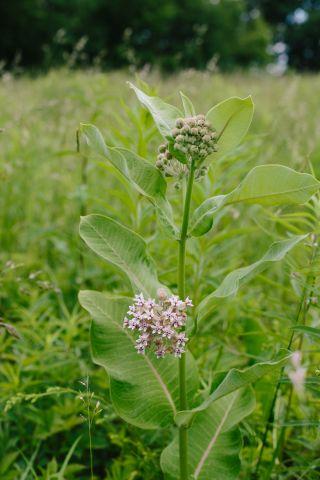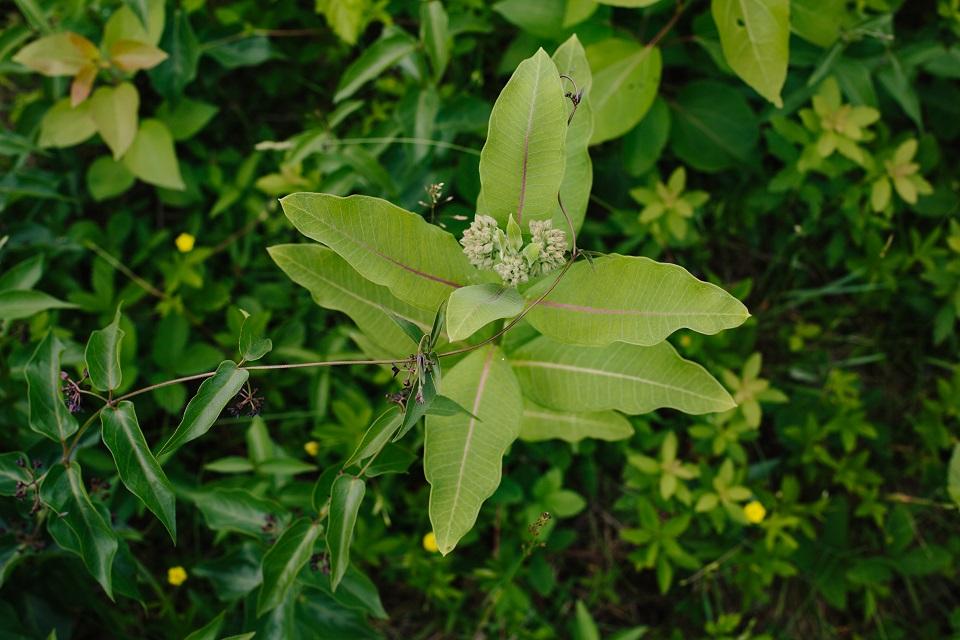Favoring common milkweed
- Tags:
- Wildlife,
- Stewardship

Most of the land that the Forest Society manages is forestland, but we also own over 450 acres of fields throughout the state. These areas provide valuable habitat and plant diversity on our landscape and are often havens for wildlife. We lease some of our fields to local farmers, who grow and cut hay for livestock. This provides the Forest Society a way to keep these fields open, and benefits the farmer by providing a crop. This arrangement stipulates that the farmer maintain the fertility of the fields and take into account ground-nesting birds if possible. In fields that can’t be hayed, we hire mowing contractors to cut the vegetation every year or three to keep them open.
Because of a recent project to establish an American chestnut seed orchard on the Tom Rush Forest, I’ve been spending some time recently in a wonderful field by the orchard that is positively buzzing with pollinators at the moment. Right now, it’s a beautiful mix of queen Anne’s lace, goldenrod, red clover, and meadwosweet. It also has a ton of milkweed plants, which were in bloom a couple weeks ago and currently have swelling seed pods. I noticed several monarch butterflies in the field the other day, likely flying around looking for milkweed plants to lay eggs on. Habitat for pollinators and milkweed plants for monarch foodplants has been an increasing focus for the conservation community; the 2019 International Monarch Monitoring Blitz just wrapped up a few weeks ago. This year, the Forest Society has embarked on a stewardship project aimed at improving this particular field’s suitability for monarchs.
Unfortunately, the fields on the Tom Rush Forest are being overtaken by black swallowwort,

In early July, we mowed as much of the swallowwort on the fields at Tom Rush that we could do using a mowing contractor and summer interns with weed whips. The timing was aimed at knocking the plants back before they could go to seed, which would have occurred around the beginning of August. The plants will sprout back however, as they have a strong root system. After they sprout back (and hopefully before they have time to put out a second round of seed), we will be conducting a targeted herbicide treatment to kill the root system and provide a better control of most of the plants. For landowners with one or two plants in their yard, it is probably feasible to hand-pull each plant, making sure to get the whole root system. The infestation in our fields was far more widespread, thus necessitating the use of herbicides. We consulted with the Hillsborough County Forester for advice, and we would recommend others with questions about how to deal with invasives on their lands contact their local county forester as well.
This project will require periodic follow-up work to prevent the swallowwort from becoming re-established in the fields, but we are hopeful about our ability to knock back the population on Tom Rush Forest significantly. This will provide benefits to the monarchs that I’ve seen in abundance on the property, as well as other insects that seek out pollinator fields such as this one.
If you’d like to learn more about the fields on Tom Rush Forest, please consider attending an upcoming field trip on the property.
